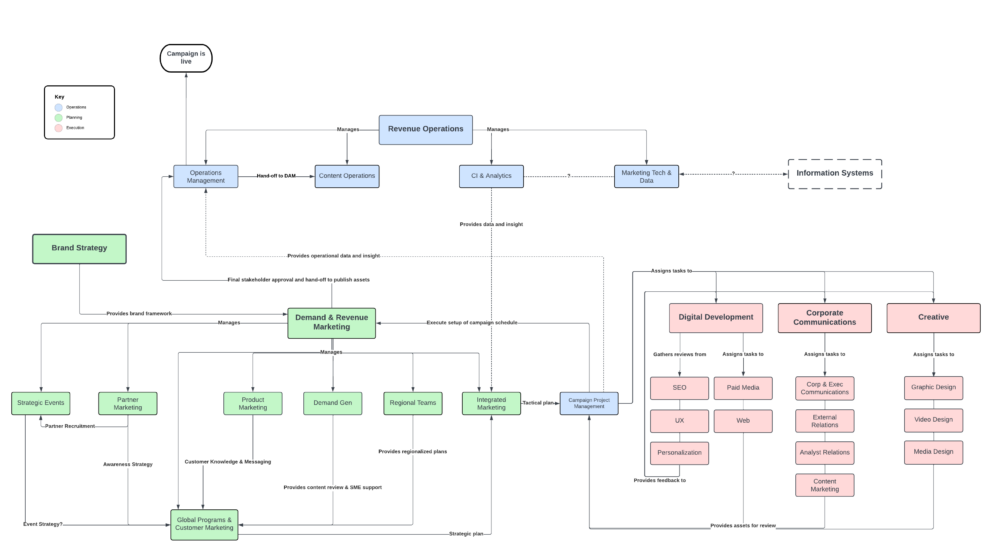By Tom Swanson, Engagement Manager at Heinz Marketing
CLG (customer-led growth for the unaware) is another entry in the X-Led Growth trend. Taking away the fancy name and buzzy acronyms, the concept has been around for a long time. Whether integrating Voice-of-the-Customer efforts, building customer marketing strategies, or writing a simple customer nurture, extracting more value from existing customers than pushing hard for new ones is marketing 101.
So why is it so hard to do?
Every business is different, but the most common problem I see by far is silo-ing. Misaligned objectives, inconsistent communication, and poor hand-offs are all contributors to this issue.
Today we are focusing on misaligned objectives and incentives.
I will share some of our own experiences and best practices to help establish aligned incentives, and orchestrate your teams effectively to foster customer-led growth.
Understanding the Silo Problem

One of the main drivers of silos within organizations is the misalignment of incentives and goals. When different teams are measured and rewarded based on disparate metrics, they gravitate towards isolation, focusing on their own objectives rather than how the company grows together. This leads to fragmented customer experiences and hampers overall growth.
Best Practice Insight: Start with the metrics
Go back to the grassroots with customer focus: All the business greats talk about the customer focus, nothing new here. However, if you have misalignment in your GTM teams, this is the place to start looking. From our work, here are some suggestions for how you can re-evaluate your customer-focus.
- Review your customer data to see what the characteristics are of your best customers.
AI suggestion: Upload deal notes and data to ChatGPT and ask it to evaluate the notes looking specifically for what works for your best customers. - Record interviews with your teams about their goals/incentives, and seek out where they might be misaligned.
AI suggestion: Upload the transcripts to ChatGPT and ask it to run a language and sentiment analysis. You are looking for areas where your teams are not on the same page, it can find some stuff you might have missed. - Ensure all GTM teams are having regular conversations with customers.
Marketing loves a good Customer Advisory Board (CAB). - Talk to your CS team about what support they need.
They will be crucial to any CLG motion, so get their buy-in through listening.
Establishing Unified Metrics
To align your GTM teams effectively, start by implementing shared metrics that reflect customer success. Metrics like Net Promoter Score (NPS), Customer Satisfaction (CSAT), and Customer Lifetime Value (CLTV) are critical to evaluate what is working.
Key Steps:
- Define Shared Goals: Ensure that all teams have a clear understanding of the overall company objectives and how their roles contribute to achieving them.
- Implement Shared Metrics: Use metrics that can be applied across different teams to gauge their performance in contributing to customer success.
- Regularly Review Metrics: Schedule regular cross-departmental meetings to review these metrics, discuss progress, and identify areas for improvement.
Aligning Incentives
Once you have unified metrics in place, the next step is to align incentives across your teams. Incentives should be structured to promote collaboration and shared responsibility for customer outcomes.
Consulting Insight: Incentives are most often the cause of misalignment
Incentivize collaboration: Incentives/evaluation should not only focus on individual performance or team-level performance but also cross-functional collaboration and the achievement of shared goals. This can include bonuses for hitting collective targets related to customer retention and satisfaction, if you have the budget. Otherwise, you may consider promotional tracks for the individuals that are organizing and aligning across teams. Design incentives to fit with whatever your internal structures are for upholding company values.
How to orchestrate it
Ah, back to logistics. The objective is for all teams to work in harmony towards common goals. Doing this demands clearly defining roles, establishing robust communication channels, and fostering a culture of collaboration.
No doubt it is fiddly and requires constant vigilance, but that’s leadership. If you don’t live it, your teams won’t either.

This ecosystem chart shows how teams work together, you can build something similar for incentives to show where they connect across functions.
Key Elements of Marketing Orchestration:
- Clear role definition: Use frameworks like RACI (Responsible, Accountable, Consulted, Informed) to clarify roles and responsibilities. This helps to avoid confusion and ensures accountability.
- Robust communication channels: Establish regular communication channels between teams to ensure information flows seamlessly. This can include weekly sync-ups, collaborative platforms, and integrated workflows.
- Collaborative culture: Foster a culture where collaboration is valued and recognized. Celebrate team achievements and encourage knowledge sharing across departments.
- Good governance: Be consistent about meeting with your leads on the process. You need to be diligent in making slight adjustments to improve outcomes, then giving them space to breathe. Good governance isn’t constant tweaking, but it is pretty frequent.
Practical Steps to Break Down Silos
- Cross-Functional Teams: Create cross-functional teams that include members from different departments. This promotes diverse perspectives and encourages collaboration on shared projects.
- Regular Training: Provide regular training on customer-centric practices and the importance of unified goals. This helps to align team members with the overall vision of customer-led growth.
- Leadership Buy-In: Ensure that leadership is committed to alignment and actively promoting a customer-centric culture. Leadership should actively participate in cross-departmental meetings and customer interviews to lead by example.
How to Tell if it is Working
If you are in marketing, chances are you are comfortable with things not being entirely 1:1 – action:outcome. We often have to deal in proxy metrics with leading and lagging metrics to help us see impact. This is no different. Anything people-related is going to be a bit ambiguous, but here are some options for what to look at within your customer growth:
- Quantitative Leading
- Content engagement among customer accounts
- Growing body of customer-centric content
- Quantitative Lagging
- Faster sales cycles
- Lower churn
- Upwards-trending CLV
- Shorter CAC-payback period
- More referrals
- More expansion deals
- Qualitative Leading
- CS feedback/surveys
- Regular meetings occurring
- Customer-centric content being produced
- Qualitative Lagging
- Better customer reviews and NPS
- Higher customer satisfaction
Conclusion
Aligning your GTM teams around customer-led growth requires a deliberate effort to break down silos, establish shared metrics, and align incentives. By focusing on effective marketing orchestration and fostering a collaborative culture, you can ensure that all teams are working towards the common goal of delivering exceptional customer experiences.
Start implementing these practices today to drive meaningful growth and customer success. Let me know how it goes for you: acceleration@heinzmarketing.com
The post De-Siloing GTM Teams for Customer-Led Growth appeared first on Heinz Marketing.


